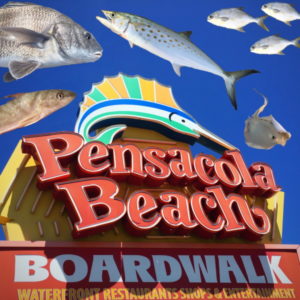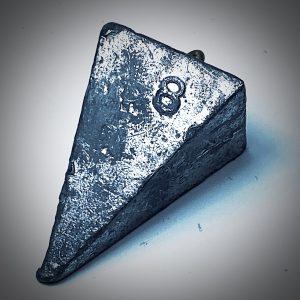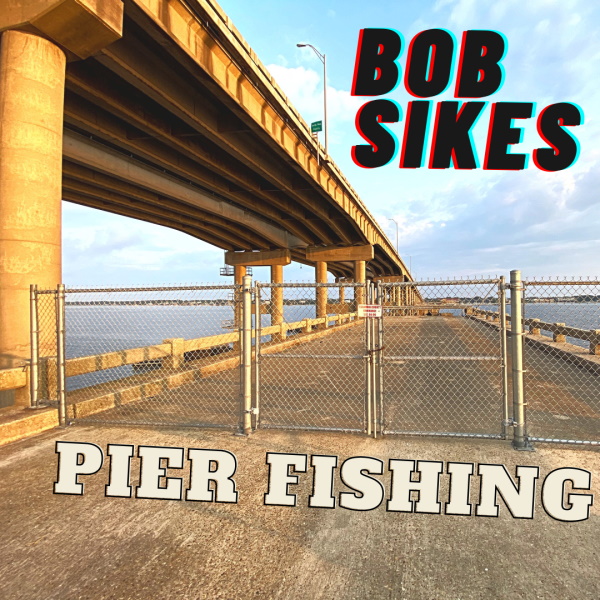
To fish the Bob Sikes Pier, you’ll first have to determine which section of the pier you want to visit. There is a northern section, and a completely separate southern section. You cannot reach one from the other. Most visitors choose to park out in front of the Grand Marlin restaurant, just beyond the toll booth, and fish the southern part of the pier.
While it’s not necessary, It’s best to have a cart to transport your gear down the concrete walkway. Take a couple rods and some live shrimp, and focus your efforts around the bridge pilings underneath the adjacent bridge. You can expect to have a chance to catch redfish, black drum, flounder, mangrove snapper, and many other species.
About The Pier
Bob Sikes bridge, not to be confused with “3 Mile Bridge”, is a great backup plan when it’s too rough to fish the beach.
There is a lot to like about this fishing spot. Firstly, there is no entry fee or parking fee to fish the pier. It’s also open 24 hours a day, and has great ease of access. You cannot drive vehicles onto the bridge, but it’s a fairly easy walk to get onto the pier. Best of all, it’s usually loaded with fish.
The area is well lit and typically clean, except for the usual sightings of old leftover bait here and there. The rain and the birds do their best to keep it cleaned up, but you can expect to see old bait left behind by other anglers.
There are trash cans conveniently placed along the entire length of the bridge, which helps to keep the whole area tidy. There is so much space to fish here, that it’s rarely ever too crowded. No wonder this is one of the most popular fishing destinations in Pensacola.
Bob Sikes Is Really 2 Separate Piers
The “pier” is actually an old bridge with the middle section removed. It has been since replaced by a taller bridge running alongside it. The two end sections of the original bridge are now 2 entirely separate fishing piers, collectively referred to as the Bob Sikes Fishing Pier.
The further you walk out onto either pier, the deeper it gets, to a point. Then, it’s basically the same depth except for certain spots. So, you don’t necessarily have to walk that far out to get into some good fishing. With that said, I can’t resist going close to the end, and away from the crowd. It is over a 500 yard walk to get to the end, so a cart is nice to have.
North Section Of The Bridge In Gulf Breeze
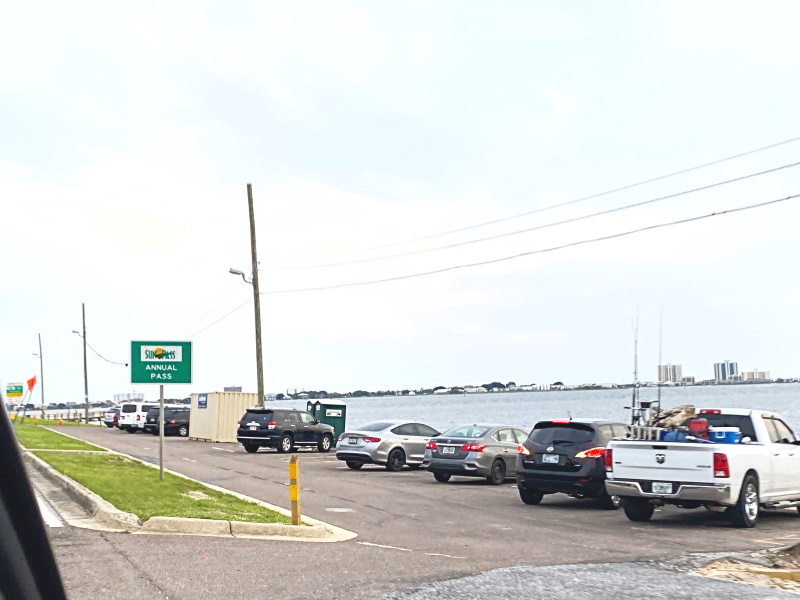
To access the northern section of the bridge you will have to park across the street from the Santa Rosa Yacht & Boat Club. Then you can walk across the busy street and down a narrow entryway to get to the bridge.

Access to the north section is generally considered less desirable than on the southern end. You have to cross 4 lanes of traffic on foot with all of your gear in tow. In all honesty I have not fished the northern end. One day I parked in the lot, pictured above, intending to try it, and I quickly changed my mind. After seeing the volume of speedy traffic coming across the bridge, I decided the southern end was good enough for me 😉
It seems like more anglers gravitate to the southern section due to it’s ease of access. You’ll pretty much be fishing for the same species no matter which end you choose. So, I don’t think it really matters all that much.
Southern Section Of The Bridge In Pensacola Beach
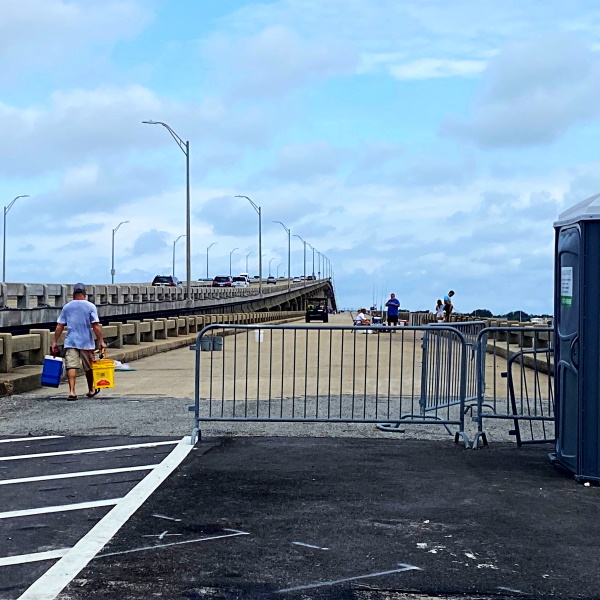
The southern section of the pier, also sometimes referred to as the “beach side” is in Pensacola Beach. To access it, park in front of the Grand Marlin restaurant, as shown below, and walk onto the bridge as shown above. Ignore the traffic cones in the picture below. They were just there because they were working on the parking lot that day.
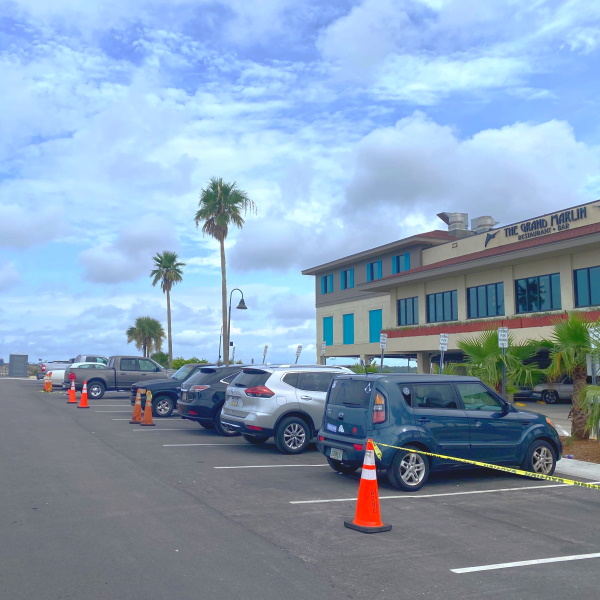
Near the end of the pier, you’ll encounter a chain link fence that blocks your access to the very end of the pier. I don’t attempt to go around this fence, and I wouldn’t recommend you do either. If you fall, it’s a long way to the water – about 20 feet.
It’s Free! Sort Of
There is no entry fee to fish either pier. However, depending on where you are coming from, you could have to pay a small toll fee to cross the bridge in your vehicle in order to reach the pier. As discussed, there is actually 2 separate piers, so you can usually avoid a toll fee altogether, if so desired.
Because this is a non-fee pier, you’ll have to have a valid saltwater license to fish the Bob Sikes bridge. This is unlike the ocean-facing piers in the area that have a fee to fish them. The pay-to-fish piers usually include the license fee into the cost of the entry fee.
It’s Peaceful, Sort Of
The traffic noise from the adjacent bridge is not nearly as intrusive as I thought it might would be. The road is elevated enough above you that it’s not so bad. The scenery more than makes up for it. Expect to see beautiful sunrises, dolphins, birds, boats, and occasional schools of fish. Last I was there a large school of rays glided by right below my feet.
Pier Supplies You’ll Need
- Pier Net or “Drop Net”
- Bait and aerator
- Cooler With Ice
- Tape Measure
- Pier cart or surf cart
- Towel to wipe hands
- Pliers
- Fish Lip Gripper
- Plenty Of Terminal Tackle
- Beach Chair
- Lures
- Knife
- Rods and Reels
- Drinks
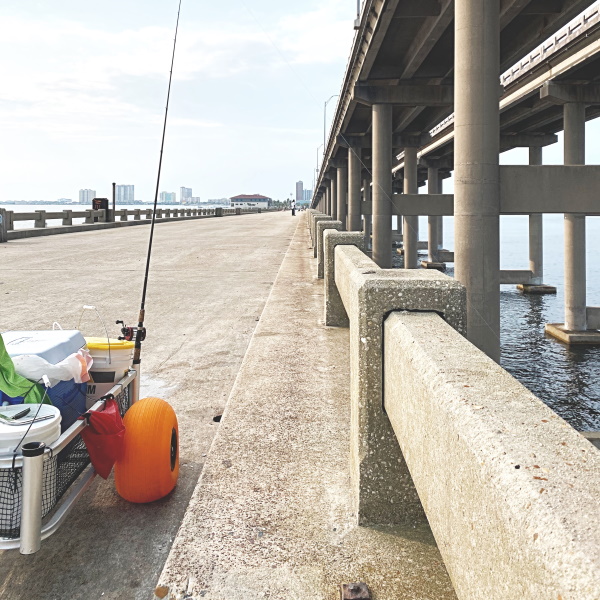
Make sure you have plenty of extra terminal tackle and weights because your line will fray and you will likely get broken off some. Also, don’t come out onto the pier without some type of bait. I personally would not want to rely on finding good bait once on the pier. Some days it’s hard to come across good bait out there, so you don’t want to arrive empty handed.
I like to take a lightweight folding beach chair with me. You know the old school folding chairs, not the bag chairs. They will sit nicely sideways up on the ledge for a slightly better view when the fishing is slow. Bag chairs won’t sit on the ledge. It’s not a huge deal. Just my personal preference. Regardless of what kind you bring, you should take something to sit on.
You’ll need all the normal fishing gear here as you would on any other pier. Bring a cooler, a pier net, a bait bucket, a tape measure, pliers, a knife, some lures, and other such gear as listed above. I would also invest in a cart of some sort to drag all this stuff out there. It doesn’t have to be fancy. Just about anything you buy with wheels will roll well on the concrete walkway.
What Can You Catch On Bob Sikes Bridge?
There’s actually quite a long list of species that you might hoist up at Bob Sikes. The more desirable fish you may encounter are red drum, Spanish mackerel, sheepshead, mangrove snapper, flounder and speckled trout. You can even hook into things like grouper and pompano here. Other less desirables that you will encounter are rays, ladyfish, catfish, sharks, pinfish, pigfish and lizardfish. You just never know what you’ll get into out there.
Redfish
Red drum are probably one of the most sought after species when fishing this pier. You can catch both slot reds and bull reds here using a fish finder rig with 3-6″ live baits, such as pinfish and finger mullet, or by using various cut baits. Cut up pieces of blue crab, mullet, ladyfish, menhaden, whiting, white trout, and croaker all work for redfish.
Black Drum
Besides big ole redfish, you can also often catch their uglier cousins, the black drum. Drop a shrimp or piece of crab down around the pilings.
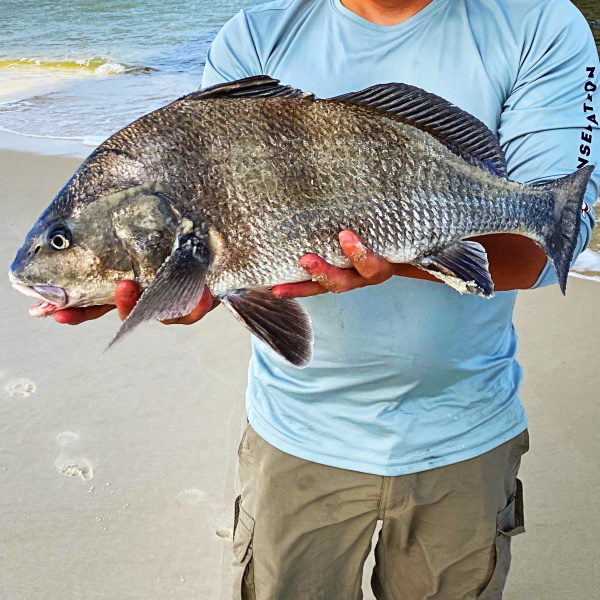
Sheepshead
Sheepshead are very tasty and have a generous limit of 8 in Florida, so they are a great target. They love any kind of structure that harbors barnacles, and this pier certainly qualifies.
For your best shot at sheepshead, target them during late winter beginning in February into early spring. Use a fish finder rig with 12-18″ of fluorocarbon leader and a fiddler crab or shrimp as bait. For more info, check out the sheepshead article on my site.
Mangrove Snapper aka Black Snapper
Mangrove snapper, also known as black or gray snapper, can really stack up here at times and are not that hard to catch when biting. Drop a live shrimp, pinfish or LY down on a Carolina rig to the bottom near the pilings. Mangroves only have to be 10″ in Florida and the limit is 5, so they are a great species to target for the table. Everyone loves to eat snapper.
Spanish Mackerel
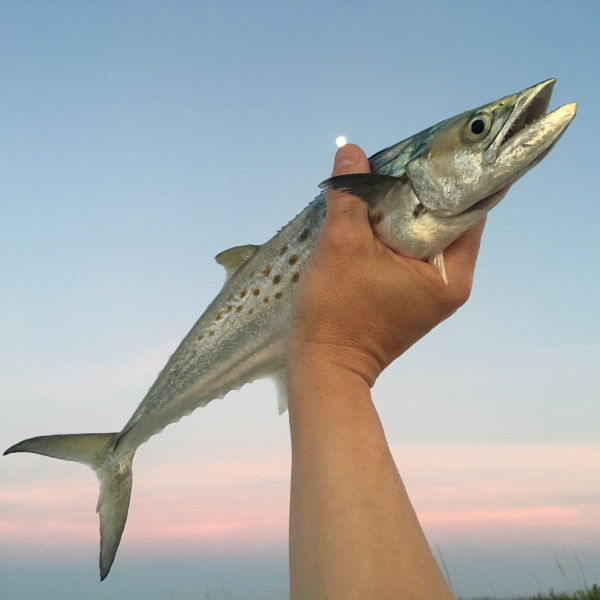
The same live shrimp you use for other species will also work for Spanish, as will LY’s and other similar small bait fish. Freelining your baits out will often get you into the action when Spanish are around. You can also toss Gotcha! lures and other small fish imitating artificials with a strong leader to target them.
Flounder
To target flounder, send a bull minnow or live shrimp to the bottom on a Carolina or fish finder rig. Flounder must be 14″ to keep.
Speckled Trout
Free line or use a very light weight to drift live shrimp or some type of small bait fish to tempt any feeding trout. See a pattern here? It’s hard to beat a bucket of live shrimp on the bridge.
White Trout
Like many of the other fish you will be targeting from the pier, white trout are bottom dwellers. Use a 1 or 2 hook bottom rig or a fish finder rig to put a piece of cut bait on the bottom. Live or dead shrimp will also work for this species – shocker! White trout can provide much needed action in the colder months.
Spadefish
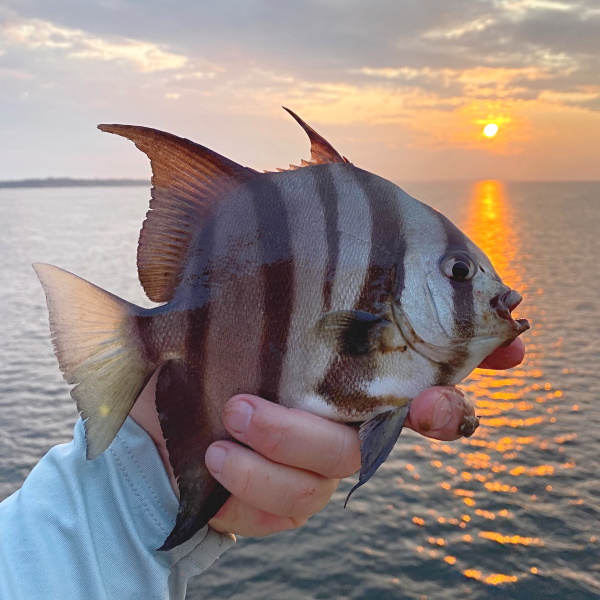
Although spadefish are not a highly sought after species, they can sometimes be quite prevalent along the pier. I often catch smaller ones with a sabiki rig when I’m trying to catch bait. Some folks do consider them to be quite tasty, so why not give them a try.
Landing Big Fish
Make no mistake, this is an excellent big fish location, but you’ll need to use some decent equipment and skill to keep a larger fish out of the bridge pilings. If you are lucky enough to coral a trophy to the surface without getting broke off, you’ll need a pier net, aka drop net, in order to lift him up. This is much easier when fishing with a partner, but you can usually get someone else on the pier to help you if needed.
A big fish may try to head for the pilings which will likely break you off. So, you’ll need to bring him up to the surface as quickly as you can and keep it’s head up. Try to keep the struggling fish between bridge pilings while you lower a pier net down.
When you release a big bull redfish or some other large fish, you should place them back in the net and lower them back down. Don’t just chunk the fish into the water. Also, don’t keep the fish out of the water for very long. Take a quick photo and send him back.
3 Best Rigs For The Pier
1. Fish Finder Rigs For Pier Fishing
One of the best all around rigs you can use from a pier is the Carolina, or fish finder rig. It’s a great all around option that will catch a ton of different types of bottom dwelling fish. With your bait on the bottom you’ll have a chance at catching redfish, flounder, black drum, white trout and snapper, among others.
2. Split Shot Above The Hook
A great rig to catch mangrove snapper from the bridge is to use 1 or 2 split shot on a 15-20 lb. fluorocarbon leader. Use just enough weight to get your bait to the bottom and hold it there.
In contrast, for sheepshead, use light enough weight to let your bait sink and drift down slowly against the pilings, as they might be holding anywhere in the water column. Go with a #1 or 1/0 bait hook.
You can use similar setups with very little weight to freeline and drift baits out for Spanish mackerel, and other fish that spend time higher up in the water column.
3. Sabiki Rig
Sabiki rigs are quite effective for vertical fishing on bridges and piers. They are helpful in catching live bait that can be used for larger species. However, that’s not all you’ll catch when using sabiki’s. I’ve caught lots of spadefish and other random species off the pier when using Sabiki rigs.
These disposable rigs allow you to catch fish whose mouths are too small to be effectively caught using normal size hooks. So, they are what you want to use to catch small baitfish. For best results, tip the tiny hooks with bits of shrimp. You are guaranteed some action with this setup!
Take Some Natural Bait
Hit up Gulf Breeze Bait and Tackle or Outcast Bait and Tackle to get fresh bait before heading out to the pier. Both bait stores should have several good options for whatever’s biting at the time.
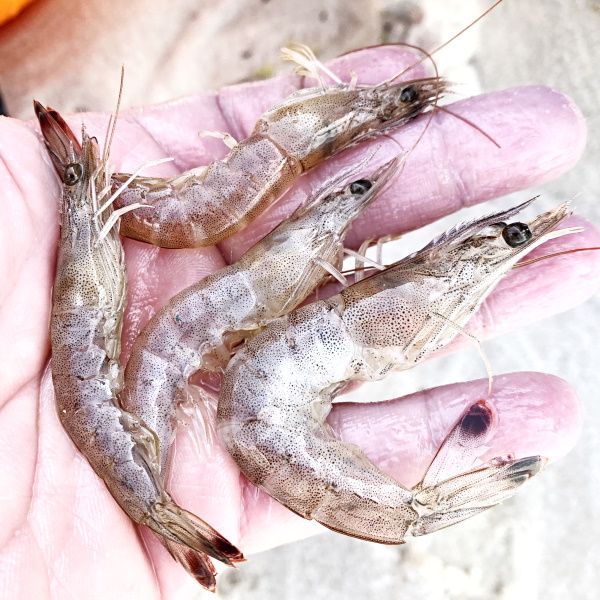
1. Shrimp
There are so many options it’s impossible to cover them all. Assuming the bait shop has some in stock, live shrimp are always a great way to go. You can either keep them in a bucket with an aerator, or you can use one of those Frabill Flow Troll bait buckets and hang it in the water tied off to a bridge railing.
Fresh dead shrimp are also good. So, if you can’t get your hands on live shrimp, go to Joe Patti’s or a local grocery store to pick up some FRESH dead shrimp.
2. Small Baitfish
Another option is to catch some of your own bait. LY’s make great bait, as does about any other small shiny fish you can come across. Small pinfish are another good option, as are cigar minnows.
Use a cast net to gather bait ahead of time if possible. Once on the pier you can try to use a castnet or sabiki rig to catch bait there as well.
3. Crabs
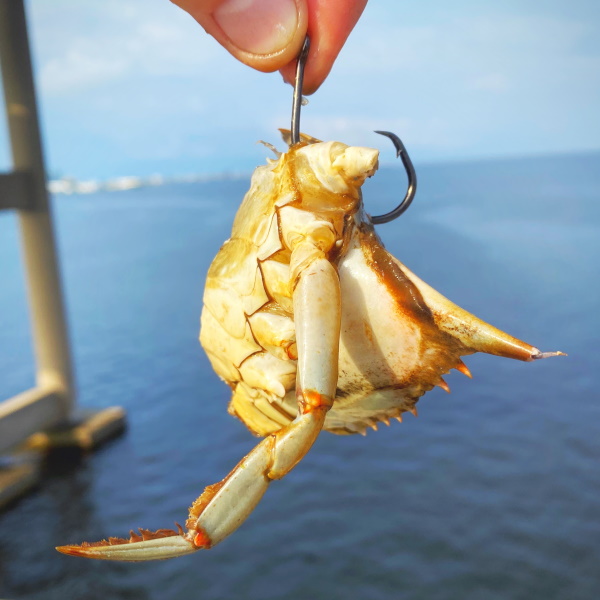
Cut blue crab is an excellent bait for the redfish and black drum that commonly lurk here, and fiddler crabs are great when the sheepshead are around. Pretty much any legal crab you can get your hands on is good bridge bait.
4. Cut Bait
Some form of cut bait will catch several different species from the bridge, most notably redfish. Use cut up pieces of mullet, ladyfish or Pinfish to entice the bottom dwellers sitting down there.
5. Lures
My preference is to use live or cut bait, but lots of different lures will also work for certain species. Gotcha plugs, jerkbaits, jigs and topwaters can all produce when schools of fish are moving through.
Which Side Of Bob Sikes Has Better Fishing?
When you walk out onto the bridge it will immediately become apparent that you’re going to have to choose which side of the bridge to fish. The bridge side (to the west) provides more consistent good fishing in my opinion. The other eastern side is more or less open water.
On the bridge side you have lots of pilings to fish around. On the open water side there are pilings immediately beneath where you are standing, but there isn’t much else out in front of you. My general preference is to mostly fish the bridge side since you have lots of fish hiding structure to fish around.
My ideal scenario is to fish the bridge side when the current is pushing my bait into the pilings out in front of me.
6 Tips For Fishing Bob Sikes Bridge
1. Fish During A Moving Tide!
This can’t be emphasized enough. Fishing under the bridge is better during a moving tide, especially when the tide is pushing your bait away from you and up under the adjacent bridge. Fish hide behind the structure just waiting for morsels to get swept by when the tide is going in or out. For many species, it’s like ringing the dinner bell. Be sure to check local tides to determine when to focus your efforts.
2. Fish The Best Areas
There are water depth changes in certain areas. These areas are going to typically hold more fish. If you can find these spots, you will have more consistent success. Unfortunately, that’s hard to do efficiently without a boat. Over time, you may notice that your bait takes a little longer to get to the bottom than it does in other areas. Pay attention to where you have the most success and file that away for future use.
3. Keep Moving
If you aren’t getting bites, don’t be afraid to move. Some spots are better than others. You’ll never find them if you don’t keep trying new spots. Fish for 20 to 30 minutes per spot and if no bits try somewhere else. Move up and down the bridge and also try both sides of it.
4. Put Your Bait Near The Pilings

Typically you don’t need to cast your bait way out into open water. Instead, you should concentrate your efforts on what’s right underneath you and nearby. You see those concrete squares in the picture above? When the tide is moving, those are great hiding spots for mangrove snapper and other desirables that hang around this area.
Most of the bottom dwelling species are going to be around the bridge pilings. That’s not to say there won’t be schools of Spanish mackerel, pompano, or something else that you’ll also want to cast to, but in general, most of the fish are under the 2 bridges.
5. Re-tie Often
Because you will be fishing around heavy structure, you will need to check your leader regularly, especially after every caught fish. Your line will get run into the pilings which will most definitely fray your leader material.
6. Don’t Fall Off The Pier!
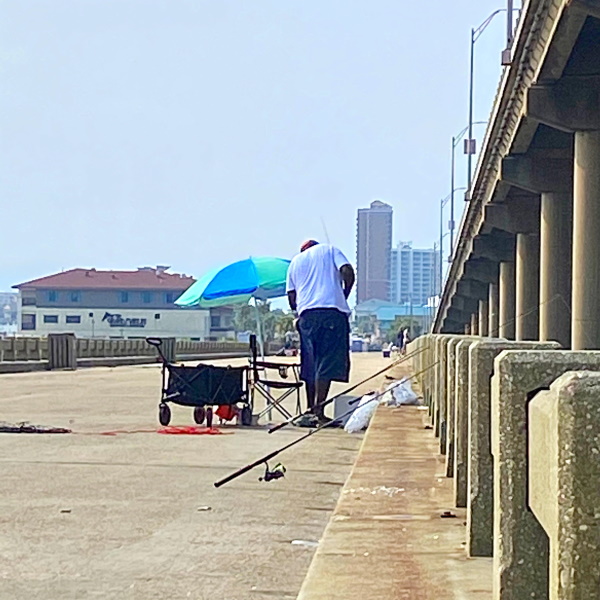
Unlike other piers, fishing from Bob Sikes can be a tad dangerous. The railing is quite low, so a misstep when handling a large fish could flip you into the drink, and that has happened…more than once. Don’t let the picture above fool you. Once you step up onto that ledge, the concrete rail is barely over knee high. So, always keep your feet under you and your wits about you. It’s about a 20 foot fall to the water.
Conclusion
Whether it be Spanish mackerel, redfish, flounder, black snapper, or something else, you’ve got a great shot at catching your dinner on Bob Sikes pier. If not, the Grand Marlin restaurant is right there at the end of the pier for a good backup plan. That’s assuming you are dressed reasonably decent and have fairly deep pockets. Otherwise, you might want to find another establishment 😉
Good luck out there!
Augustus Clay

